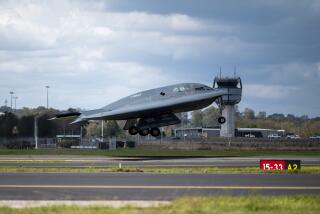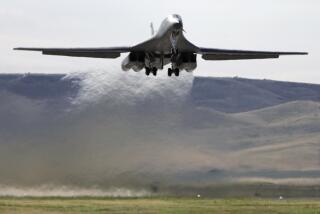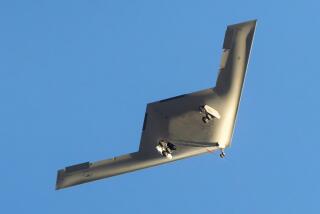Pentagon Moving B-2 Bombers to New Roosts Closer to Baghdad
- Share via
KNOB NOSTER, Mo — KNOB NOSTER, Mo. -- The Pentagon is moving the jet that fired the opening salvos of the last two U.S. wars to within easy striking distance of Iraq, erecting tent-like portable hangars for the batwinged B-2 bomber on the Indian Ocean island of Diego Garcia.
Four of the new $2.5-million maintenance hangars, each serving two planes, will be built on the British-held isle and one at Fairford, England. It will be the first time B-2s will be stationed overseas instead of here at Whiteman Air Force Base.
The foreign positioning of the radar-deflecting aircraft has been in the works for years, officials say. But the timing suggests the key role the B-2 is likely to play if there is a second war in the Persian Gulf, military analysts say.
If the U.S. launches war on Iraq, the B-2s will be critical in taking out an antiaircraft system that has been improved with fiber-optic communications and updated equipment and has had a decade to adapt to the tactics of U.S. and British planes patrolling “no-fly” zones over Iraq.
Diego Garcia is a five-hour flight from Baghdad. B-2s based there could each make three sorties every two days, military analysts say. It took nearly two days for the B-2s to reach Afghanistan from central Missouri.
The futuristic bomber -- housed at the same base the Enola Gay left to drop the first atomic bomb, on Hiroshima in 1945 -- was created to carry nuclear weapons into the Soviet Union. But by the time the first plane, the Spirit of Missouri, touched down at Whiteman in 1993, that enemy was gone.
In both Kosovo and Afghanistan, military analysts say, the B-2 adapted well to its new mission: carrying conventional weapons in the opening strike of a war.
“The B-2 bomber was designed specifically to kick the door down and kill targets,” said Col. Doug Raaburg, commander of the 509th Bomb Wing at Whiteman.
The Pentagon has long planned to station B-2s at three sites from which they can strike trouble spots throughout the world within 24 hours: Guam for Asian targets, Britain for European targets and Diego Garcia for the Middle East.
Military officials wouldn’t say exactly when the B-2s bound for Diego Garcia and Britain -- as many as 16, some of them housed in permanent hangars, out of a fleet of 21 -- will be in position. But they will be ready “in case we get the call,” Raaburg said.
Even many B-2 advocates concede that the aircraft played no more than a cameo role in Afghanistan, where air defenses were few.
But Iraq has one of the most dense air defense systems in the world. It is a hodgepodge of technology from Russia, Yugoslavia and France. Iraqi President Saddam Hussein’s regime has installed fiber-optic communications systems that are redundant, in case one is destroyed.
The Iraqis have built new facilities, reinforced others and added radar, experts say. How much of it has been destroyed by U.S. and British planes patrolling the country’s northern and southern no-fly zones remains unclear, but those areas do not include Baghdad, where Hussein has placed his best air defenses.
“We didn’t have to use the B-2s in Afghanistan because you didn’t need it,” said Rep. Norman D. Dicks (D-Wash.), an unabashed B-2 aficionado. “You’re going to need it in Iraq.”
After its introduction in 1993 at a cost of $2 billion each, the B-2 was criticized as too delicate -- critics erroneously said it couldn’t fly in the rain -- and too expensive. But since the devastating opening bombing runs in Kosovo, analysts say, it has become the Pentagon’s first-strike weapon.
Eight B-2s could drop as many as 576 bombs on Iraqi air defenses in the first three days of a war, seizing control of the airspace. It takes three minutes for a B-2 to drop 16 satellite-guided “smart” bombs. It is the only plane that can carry the 5,000-pound explosive that crew members call “the crowd pleaser,” which burrows up to 20 feet into rock and destroys underground bunkers with massive force.
Some analysts predict that after the first few days of an assault on Iraq, the B-2s would be shuttled off to the sidelines, as they were after performing just six missions in Afghanistan.
But others note that during the entire 1991 Persian Gulf War, the plane that Gen. H. Norman Schwarzkopf used most to bomb targets in Baghdad was the earlier-generation stealth fighter, the F-117, because it could evade detection. With a second war likely to focus far more firepower on the Iraqi capital, the B-2 would be the weapon of choice, perhaps along with F-117s, said John Pike, a defense analyst at GlobalSecurity.org, an Alexandria, Va., research group.
“Baghdad is the center of gravity in this war, so I would suspect that the B-2s would be going downtown until the war is over,” Pike said.
Placing B-2s at Diego Garcia frees up bases nearer Iraq to host shorter-range bombers and fighters in Qatar, Kuwait, Turkey and Jordan. The U.S. Central Command recently made room for the B-2s by moving B-1 bombers from Diego Garcia to Amman, Jordan.
After the introduction of the B-2, which was built in Palmdale by Northrop Grumman, war planners were skittish about using it. They feared that losing a $2-billion plane would cause a political backlash at home.
No one knew for certain how well it would work in combat, where the pilots are extremely vulnerable if spotted. Flying a B-2 is something of an act of faith.
It has no high-speed afterburner, no missiles to return fire -- nothing to protect it but stealth.
It is called the stealth bomber because its sleek shape helps it evade radar. Maintaining the shape of the smooth composite skin is such a delicate endeavor that maintenance crews cover seams, rivets and any dents from bugs or birds with radar-absorbing tape after each mission.
The painstaking maintenance, which would be done at Diego Garcia in the new portable hangars, can mean the difference between life and death.
One kink in the body could tip off ground radar to the bomber’s location. Air Force officials believe that the only stealth fighter to be shot down, an F-117, was struck in Yugoslavia because radar on the ground bounced off the open bomb bay doors.
Whatever the risk to the pilots, any missions from Diego Garcia to Baghdad would be over in the wink of an eye, comparatively speaking.
B-2 pilots fly missions never envisioned before -- a record 44 1/2 hours to Afghanistan, by circuitous routes -- and they have forged their own on-board lifestyle. The trips are so long that pilots consulted sleep therapists. (They were advised to load up on carbohydrates and sleep either less than 45 minutes or more than two hours to avoid the drowsiness brought on by waking during a deep sleep.)
Pilots steal naps in lounge chairs from Kmart that they stash behind the two seats.
After a lengthy trek to the target, they turn around and head home without ever seeing the ground.
“At no other time in the world are you so removed yet so involved,” said a B-2 captain who asked to be identified by his codename, Pita.
More to Read
Sign up for Essential California
The most important California stories and recommendations in your inbox every morning.
You may occasionally receive promotional content from the Los Angeles Times.










